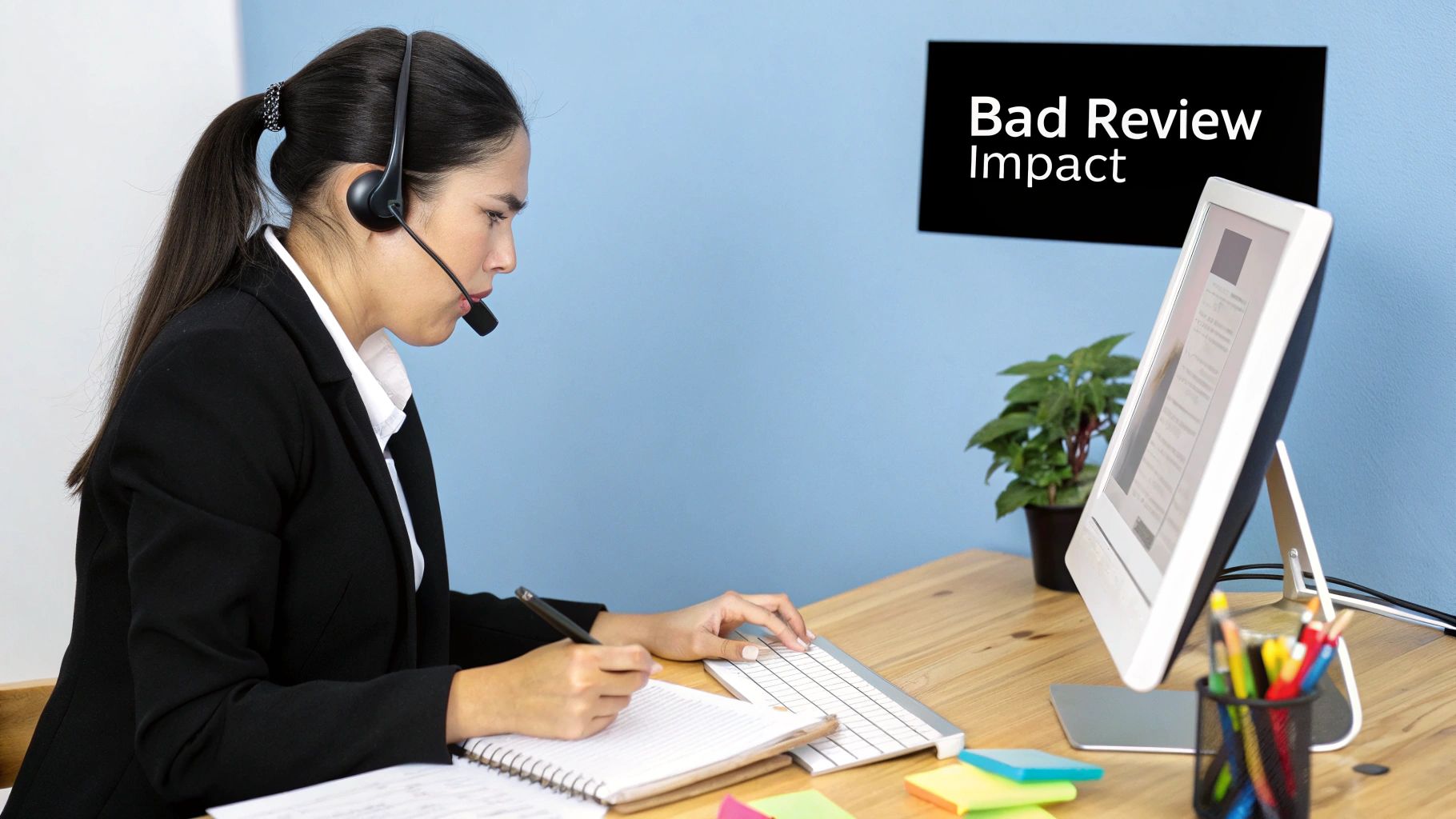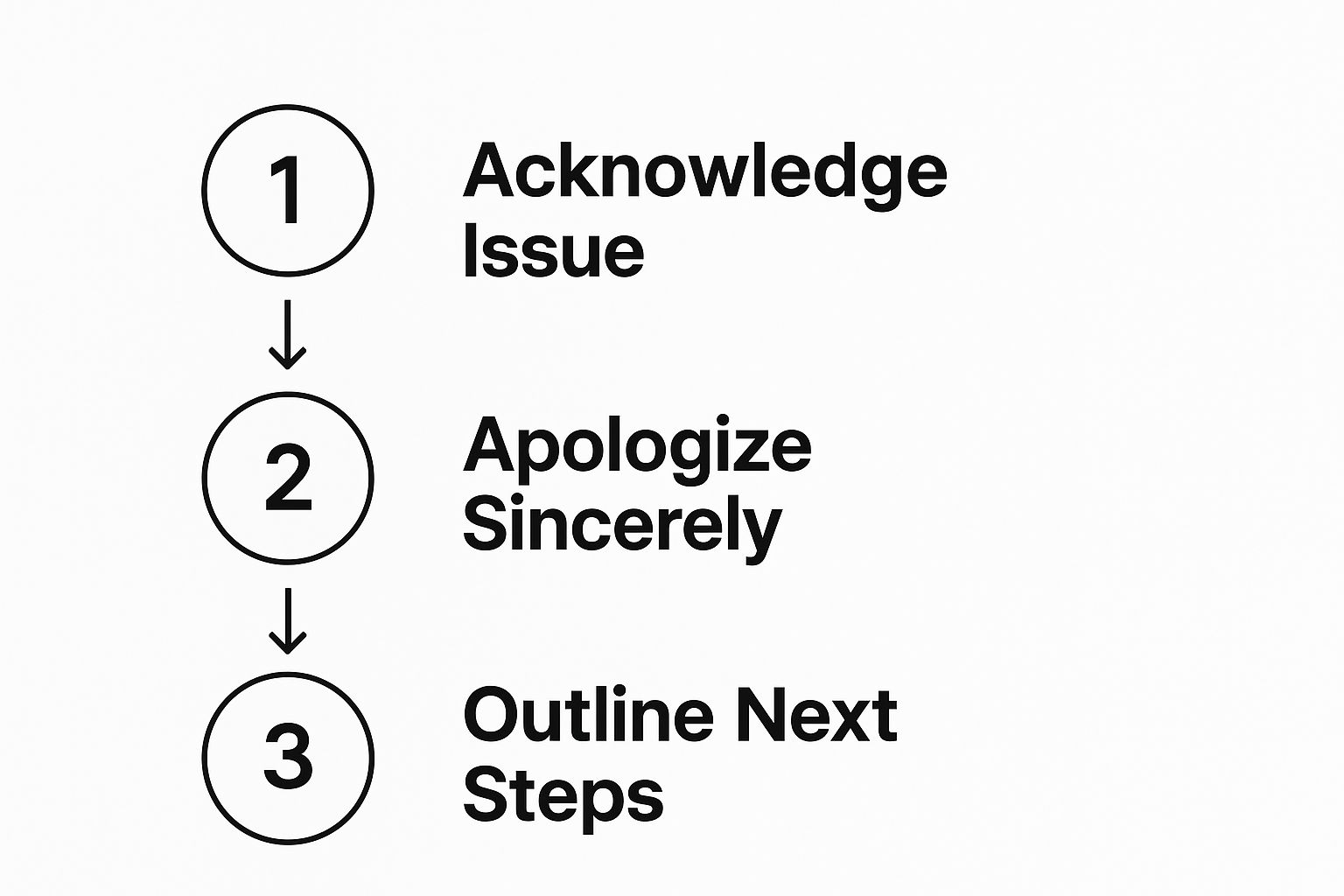Let’s be clear: responding to a bad review isn’t an admission of guilt. It’s a public display of accountability and a genuine commitment to your customers. Instead of seeing criticism as a personal attack, think of it as a golden opportunity. You get to showcase your brand’s integrity, solve a real problem, and prove to every potential customer watching that you actually listen.
Why Responding to Bad Reviews Is Not Optional

Ignoring a negative review is one of the worst things a business can do. It sends a loud and clear message to both the unhappy customer and the silent majority of prospects reading along: you just don’t care.
In an environment where a staggering 89% of customers read business responses, your silence speaks volumes. It’s often interpreted as indifference or, even worse, arrogance. A bad review left to fester becomes the final, undisputed word on that customer’s experience, cementing a negative story about your brand.
A thoughtful, quick response can flip that script entirely. It turns a monologue of complaints into a productive dialogue. It shows that your business is about more than just transactions; it’s about building relationships.
The Audience Is Bigger Than You Think
When you reply to a negative review, you’re not just talking to one person. You’re speaking to every single potential customer doing their homework on your business. They’re watching to see how you handle a little heat. Do you get defensive? Do you gloss over the real issues? Or do you own it and offer a real solution?
Your public response is actually a powerful piece of marketing. It shows everyone that you are:
- Accountable: You acknowledge when things don’t go as planned and take responsibility.
- Professional: You handle criticism with grace and respect, even when it’s tough.
- Committed to Improvement: You treat feedback as a gift that helps you get better.
This level of transparency builds incredible trust. People see that if they run into a problem, you won’t leave them hanging. That confidence alone can be the final nudge that makes them choose you over a competitor who lets their bad reviews go unanswered.
Controlling the Narrative and Protecting Your Bottom Line
When you don’t reply to online reviews, it can hit your business where it hurts, potentially increasing customer churn by up to 15%. Considering 64% of consumers say they prefer buying from companies that respond to feedback, your engagement strategy is directly tied to both your reputation and your revenue.
Each response is a chance to reframe the situation, clear up a misunderstanding, or simply show that you’re committed to providing the best service possible. If you want to dive deeper, you can explore more review statistics to understand the full scope of consumer behavior.
Let’s look at the direct business outcomes of your review response strategy. One path builds your brand, while the other slowly chips away at it.
The Business Impact of Your Review Response Strategy
| Action | Impact on Potential Customers | Impact on Brand Perception | Impact on Customer Churn |
|---|---|---|---|
| Respond Actively | Builds trust and confidence. Prospects see you’re reliable and customer-focused, making them more likely to buy. | You’re seen as transparent, professional, and accountable. Your brand appears strong and customer-centric. | Reduces churn. Unhappy customers feel heard and valued, giving you a chance to retain their business. |
| Ignore Reviews | Creates doubt and suspicion. Prospects assume you either don’t care or have something to hide, driving them away. | Your brand looks indifferent, unprofessional, or arrogant. It suggests a poor company culture. | Increases churn. Customers feel ignored and disrespected, ensuring they won’t return and may warn others. |
The takeaway is simple: your responses (or lack thereof) have a tangible effect on your reputation and your bottom line.
A bad review is a problem. An ignored bad review is a crisis. The first is a single point of failure; the second is a statement about your company’s culture and its commitment to customers.
Ultimately, you can’t prevent every single negative experience from happening. That’s just business. But you have 100% control over how you react. Responding isn’t just damage control—it’s about building a resilient brand reputation that can absorb criticism and actually get stronger because of it. It shows everyone that you’re confident, customer-first, and always ready to listen.
A Practical Framework For Your Response
When a negative review pops up, the natural instinct is to react immediately. But a knee-jerk, emotional reply can do way more damage than the original bad review ever could. The best thing you can do is take a breath and follow a clear, repeatable process.
Having a solid framework isn’t about plugging in a generic template; it’s about giving your team a reliable method for handling criticism with confidence. It breaks down the response into simple, actionable parts, ensuring you hit all the right notes, every single time.
Acknowledge and Personalize
First things first: you have to acknowledge the customer’s frustration. Always start by using their name and thanking them for taking the time to leave feedback, even if it’s harsh. This simple act shows you’re listening and that a real person is on the other side of the screen.
Ditch the canned responses like, “We are sorry for your experience.” Instead, pull a specific detail from their review. If they complained about a long wait, you could say, “We understand how frustrating a long wait can be, especially when you were looking forward to your meal.”
That small touch of personalization is huge. It proves you’ve actually read and understood their specific complaint, which is crucial for de-escalating the situation and setting a constructive tone.
Apologize and Offer a Solution
A sincere apology is non-negotiable. Remember, you aren’t necessarily admitting fault for everything the customer is claiming. You’re apologizing that their experience didn’t meet their—or your—expectations. It’s an expression of empathy, and it goes a long way.
This simple visual breaks down the core flow of a strong response.

This process keeps the focus on validating the customer’s feelings before you pivot to a solution, which is key for rebuilding trust. After the apology, you need to offer a clear path forward.
Don’t just say, “We’ll do better.” Give them a concrete next step. This is your chance to take the conversation offline and handle the specifics privately.
- Offer direct contact: “Please email me directly at manager@business.com so I can learn more and make this right.”
- Promise a follow-up: “We are looking into this with our team and would appreciate the chance to connect with you personally.”
- Suggest a resolution: “We’d like to resolve this for you. Could you give us a call at [phone number] at your convenience?”
This shifts the interaction from a public complaint into a private, one-on-one problem-solving session. For those looking for more detailed strategies on this, our guide on replying to negative reviews offers additional examples.
The goal isn’t to win an argument online; it’s to show every potential customer watching that you are committed to solving problems. Your public response is for them, while your private follow-up is for the individual.
Finally, close the loop by briefly explaining how you’ll use their feedback. A simple line like, “We’re sharing your comments with our kitchen staff to improve our service speed,” shows the customer their complaint wasn’t just noise—it was valuable. This method helps you respond to a bad review in a way that protects your reputation and might even win back a customer.
Real Responses From Brands That Get It Right

Theory is one thing, but seeing how it’s done in the real world is where the lessons really stick. So let’s move past the abstract and look at a few examples of brands that absolutely nail their responses to bad reviews.
I’m going to break down the original review and the company’s reply, pinpointing exactly what they did right. These examples show how a public complaint can become a powerful demonstration of fantastic customer service, turning a frustrated customer into a potential fan.
Hotel Response to a Cleanliness Complaint
For a hotel, few things are as critical as cleanliness. How a manager handles a complaint on this topic tells every potential guest whether they can trust the hotel’s standards. This isn’t just a reply; it’s marketing.
The Bad Review:
“The location was great, but our room was a disappointment. There were stains on the carpet and the bathroom didn’t feel properly cleaned. We expected more for the price we paid.”
The Stellar Response:
“Hi Sarah, thank you for taking the time to share your feedback. I am so sorry to hear that the condition of your room did not meet our standards or your expectations. Cleanliness is our top priority, and it’s clear we fell short during your stay. I have personally shared your comments with our housekeeping leadership to ensure this is addressed immediately. We would appreciate the chance to make this right. Please reach out to me directly at [manager email] so we can discuss your experience further.”
Why It Works:
This reply is a masterclass in taking ownership.
- It’s personal. Using the customer’s name and speaking directly makes all the difference.
- It apologizes sincerely. No excuses, just a straightforward acknowledgment that they messed up.
- It demonstrates action. They didn’t just say “we’ll look into it.” They specified who they told—housekeeping leadership.
- It takes the conversation private. Providing a direct line to a manager shows they’re serious about resolving it, pulling a sensitive discussion offline.
SaaS Company Tackling a Bug Report
When you’re a tech company, a bug report isn’t just a complaint—it’s free, high-stakes quality assurance from your most engaged users. The way you respond shows everyone how seriously you take your product’s stability.
The Bad Review:
“I rely on this app for my daily workflow, but the latest update is a disaster. The main dashboard keeps freezing, and I’ve lost unsaved work twice. This is incredibly frustrating!”
The Stellar Response:
“Hi Mark, thank you for flagging this. We are so sorry for the frustration and disruption this bug has caused. Our engineering team has identified the issue with the dashboard freeze and is working on a high-priority patch, which we expect to release within 24 hours. We understand how critical reliability is, and we’ve let our users down with this update. We appreciate you bringing this to our attention.”
Why It Works:
In tech, transparency builds trust. This response gets it.
- It validates the user’s pain. Words like “frustration” and “disruption” show they get the real-world impact.
- It gets specific. Instead of a vague promise, they mention a “high-priority patch” and give a clear 24-hour timeline. That’s gold.
- It takes full ownership. “We’ve let our users down” is a humble, powerful phrase that builds massive credibility.
A great response doesn’t just solve a problem for one person; it rebuilds confidence for every customer watching. It’s a crucial element in your strategy for how to improve online reputation and demonstrate your commitment to quality.
Local Cafe Handling a Service Issue
For a small, local business, every single customer experience matters. A bad review about service can be damaging, but a thoughtful response can show the whole community that the owner truly cares.
The Bad Review:
“The coffee was good, but the service was incredibly slow. We waited 15 minutes just to place our order, and the barista seemed completely overwhelmed and was a bit rude.”
The Stellar Response:
“Hi David, thank you for letting us know about your visit. We’re very sorry that our service was not up to par and for the long wait you experienced. We were unexpectedly short-staffed on Saturday morning, but that is our problem to solve, not yours, and there’s no excuse for rudeness. We’re using your feedback in our team training this week to ensure we handle busy periods better. We’d love for you to give us another chance to show you the warm, efficient service we’re known for.”
Why It Works:
This is the perfect blend of explanation and accountability.
- It avoids making excuses. The line, “that is our problem to solve, not yours,” is brilliant. It acknowledges the reason without shifting the blame.
- It outlines a concrete next step. Mentioning “team training this week” proves they’re taking tangible action, not just offering empty words.
- It ends with a warm invitation. Asking the customer to come back shows confidence that they can, and will, do better next time.
Balancing Automation With a Human Touch
As your business scales, the flood of customer feedback can feel overwhelming. Manually crafting a unique, personal response to every single comment just isn’t realistic in the long run. This is where you need to get smart about automation—using it to stay efficient without sacrificing the human connection that actually builds loyalty.
For all the straightforward, positive reviews, templates and AI-powered tools can be a lifesaver. They can fire off quick, friendly thank-yous, making sure no happy customer is left hanging. This buys back precious time for your team to focus their energy where it’s needed most: on the negative feedback.
Why Negative Reviews Demand a Human Eye
Technology is fantastic for speed, but it has yet to master genuine empathy. When someone leaves a negative review, they’re starting a high-stakes conversation. A robotic, copy-paste reply is like throwing gasoline on a fire. The customer feels unheard, and anyone else reading it sees a company that just doesn’t care.
This is exactly why a hybrid approach is the gold standard. You use technology to manage the sheer volume of feedback, but you keep a human in the driver’s seat for the tricky situations. Your team’s role shifts from writing every response from scratch to injecting real personality, specific details, and genuine understanding into a flexible framework.
We’re seeing a clear trend here. Manual, personalized review responses have actually increased from 58% to 61% as more businesses realize how powerful that human touch is. Customers can spot a generic, canned reply a mile off, and they really appreciate the effort when a real person steps in to solve their problem.
This shift highlights a crucial lesson: efficiency should never trump empathy. You can dig deeper into these findings and see how this hybrid model is changing the game in Birdeye’s latest review response trends report.
Creating Flexible and Effective Templates
The secret to scaling your response efforts isn’t about creating rigid scripts. It’s about developing flexible templates that act more like guided outlines. A good template should empower your team, not put them in a straitjacket.
Here’s a simple way to structure them for success:
- Bookend the response: Start with a consistent, polite acknowledgment and always end with a clear invitation to take the conversation offline.
- Force personalization with placeholders: Use simple brackets like
[Customer Name]and[Reference Specific Issue]to ensure your team has to customize it. - Create a “phrase bank”: Give your team a list of pre-approved, empathetic lines to pull from. Things like, “I can absolutely see why you’d be frustrated with…” or “That’s not the experience we want for our customers.”
This approach keeps your brand voice consistent while giving your team the room they need to make each message feel personal. It’s the most practical way to respond to a bad review at scale, ensuring every customer feels heard without completely burying your support staff.
Turn That Frown Upside Down: Making Negative Feedback Your Best Asset

So, you’ve responded to a bad review. Job done, right? Not even close. In fact, the real work—the valuable work—is just getting started. Think about it: every piece of negative feedback is a free, brutally honest consultation on your customer experience. You can’t buy that kind of insight.
To really get ahead, you need to shift your mindset. Stop seeing complaints as PR headaches to be managed and start seeing them as raw data. When you treat each review as a clue, you’re no longer just defending your reputation; you’re actively building a better business.
This isn’t just about managing your online image anymore. It’s about operational excellence. The goal is to stop playing whack-a-mole with customer complaints and start fixing the root causes for good.
Build a System to Spot the Patterns
To turn scattered feedback into something you can actually use, you need a system. Don’t overthink it—a simple spreadsheet is often all you need to get going. The magic is in looking for the recurring themes that pop up again and again.
Start by creating a few simple buckets to sort the feedback into. Your categories will depend on your business, but here are a few common ones:
- Product Problems: Is the same feature confusing everyone? Is a specific item breaking too often?
- Shipping & Delivery: Are you seeing a lot of “slow shipping” or “damaged box” comments?
- Customer Service Gaps: Do multiple reviews mention long hold times or interactions with a particular staff member?
- Website/App Glitches: Are people getting stuck at checkout? Is a specific page on your site a source of frustration?
Tagging each negative review with a category like this transforms anecdotes into evidence. One customer complaining about shipping is an isolated incident. But ten complaints in a month? That’s a logistics problem you need to solve, fast.
From Insight to Real-World Action
Once you’ve identified a pattern, you have to get that information to the right people. This is where so many companies stumble. A bad review isn’t just a marketing problem—it’s an operational signal, a product development opportunity, and a training memo all in one.
Creating this feedback loop is what separates the good companies from the great ones. If you want to explore this idea further, our complete online reputation management guide dives much deeper into building a comprehensive strategy.
Here’s a simple way to channel the feedback where it needs to go:
- Boil It Down: Pull together a quick weekly or monthly summary highlighting the top 2-3 complaint themes. No need for a novel, just the key takeaways.
- Route It to the Right Team: Send the shipping complaints straight to your operations manager. Funnel the product bug reports directly to your development team. Get the feedback to the people who can actually fix the problem.
- Close the Loop (Publicly!): This is the masterstroke. When you fix something based on customer feedback, tell people! Responding with, “Thanks to feedback from customers like you, we’ve completely overhauled our checkout process,” is incredibly powerful. It shows new customers that you don’t just listen—you act.
Frequently Asked Questions
When you’re in the thick of it, managing negative feedback can bring up some tricky situations. Let’s walk through some of the most common questions I hear and how to handle them based on real-world experience.
What If the Review Is Factually Wrong?
It’s one of the most maddening things to see—a review that’s just plain wrong. Your gut reaction is probably to jump in and correct every single inaccuracy. I get it. But fighting fire with fire in a public forum almost always makes you look defensive and petty.
Instead, take a breath. The goal isn’t to win an argument; it’s to show everyone else watching that you’re the reasonable one. You can gently correct the record without starting a public spat.
Here’s how I’d phrase it:
“Hi [Customer Name], thank you for taking the time to share this with us. I’m really sorry to hear your experience didn’t line up with what we aim for. Based on our records, there might be a mix-up on a few details, and I’d love the chance to clear this up with you directly. When you have a moment, could you please email us at [contact email] so we can sort this out?”
See what that does? It validates their frustration while smoothly moving the detailed, potentially messy conversation offline.
How Quickly Do I Need to Respond?
Speed matters, but not at the expense of quality. Firing off an emotional, knee-jerk reply moments after you read a review is a recipe for disaster. But on the flip side, letting it sit for a week sends a clear message: you don’t care.
The sweet spot is to respond within 24 to 48 hours.
Think about it from the customer’s perspective. Over 53% of them expect a response within a week anyway, so a quick, thoughtful reply makes you look incredibly proactive and attentive. It shows both the unhappy customer and every potential customer reading the reviews that you’re on top of your game.
Should I Ask a Customer to Delete a Bad Review?
Let me make this simple: No. Absolutely not.
Directly asking someone to take down their bad review is one of the worst things you can do. It feels like you’re trying to bully or bribe them into silence, and it can backfire spectacularly. I’ve seen customers get so offended they update their review to include the takedown request, which makes you look even worse.
Your real goal is to solve their problem so effectively that they decide to update or remove it on their own. Once you’ve handled their issue privately and they seem happy, you can wrap things up by saying something like, “I’m so glad we were able to get this sorted out for you. We genuinely appreciate you bringing this to our attention—it helps us get better.”
That’s it. You’ve done your part. The ball is now in their court, and you’ve handled the situation with integrity.
Ready to take control of your online reputation and turn feedback into fuel for growth? Reviews To The Top provides a single, powerful platform to monitor, manage, and respond to customer reviews, ensuring you never miss a chance to build trust. See how we can help you climb the rankings and win more customers.
